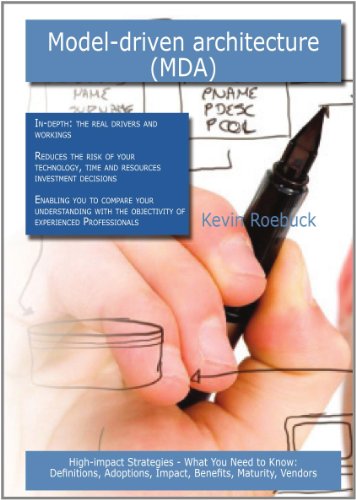High-Assurance Design: Architecting Secure and Reliable Enterprise Applications
暫譯: 高保證設計:架構安全可靠的企業應用程式
Clifford J. Berg, Cliff Berg
- 出版商: Addison Wesley
- 出版日期: 2005-10-01
- 售價: $2,430
- 貴賓價: 9.5 折 $2,309
- 語言: 英文
- 頁數: 696
- 裝訂: Hardcover
- ISBN: 0321375777
- ISBN-13: 9780321375773
已絕版
買這商品的人也買了...
-
 MATLAB 程式設計-入門篇, 2/e
MATLAB 程式設計-入門篇, 2/e$600$199 -
 Operating System Principles, 7/e(IE) (美國版ISBN:0471694665-Operating System Concepts, 7/e) (平裝)
Operating System Principles, 7/e(IE) (美國版ISBN:0471694665-Operating System Concepts, 7/e) (平裝)$1,100$1,078 -
 圖表王─統計圖表展現數據說服力
圖表王─統計圖表展現數據說服力$450$351 -
 Security Patterns: Integrating Security and Systems Engineering (Hardocver)
Security Patterns: Integrating Security and Systems Engineering (Hardocver)$2,810$2,670 -
 Microsoft Visual C# 2008 精研講座
Microsoft Visual C# 2008 精研講座$650$514 -
 新 Excel VBA 與 Office 其他程式整合實務講座
新 Excel VBA 與 Office 其他程式整合實務講座$480$374 -
 Linux 驅動程式, 3/e (Linux Device Drivers, 3/e)
Linux 驅動程式, 3/e (Linux Device Drivers, 3/e)$980$774 -
 精通 MFC 視窗程式設計─Visual Studio 2005 版
精通 MFC 視窗程式設計─Visual Studio 2005 版$750$593 -
 Software Engineering, 8/e
Software Engineering, 8/e$790$774 -
 超圖解 Excel VBA 基礎講座
超圖解 Excel VBA 基礎講座$420$357 -
 MySQL 5 徹底研究, 3/e (The Definitive Guide to MySQL 5, 3/e)
MySQL 5 徹底研究, 3/e (The Definitive Guide to MySQL 5, 3/e)$690$538 -
 聖殿祭司的 ASP.NET 2.0 專家技術手冊─使用 C#, 2/e
聖殿祭司的 ASP.NET 2.0 專家技術手冊─使用 C#, 2/e$720$569 -
 Sams Teach Yourself Visual C# 2005 in 24 Hours, Complete Starter Kit
Sams Teach Yourself Visual C# 2005 in 24 Hours, Complete Starter Kit$1,620$1,539 -
 Microsoft LINQ 最佳實務講座
Microsoft LINQ 最佳實務講座$550$435 -
 $399Professional Microsoft Smartphone Programming
$399Professional Microsoft Smartphone Programming -
 駭客攻防技術擂台─Vista、XP 全適用
駭客攻防技術擂台─Vista、XP 全適用$520$442 -
 寫給 SA 的 UML/MDA 實務手冊
寫給 SA 的 UML/MDA 實務手冊$350$298 -
 Joomla 1.5.x 網站架設寶典
Joomla 1.5.x 網站架設寶典$490$387 -
 提案王─最能凝聚傳達力的簡報提案與企劃技術
提案王─最能凝聚傳達力的簡報提案與企劃技術$450$351 -
 如何設計好網站─無廢話 XHTML & CSS (HTML Dog: The Best-Practice Guide to XHTML and CSS)
如何設計好網站─無廢話 XHTML & CSS (HTML Dog: The Best-Practice Guide to XHTML and CSS)$450$383 -
 Advanced Windows Debugging (Paperback)
Advanced Windows Debugging (Paperback)$2,380$2,261 -
 VBScript 500 個活用範例 Windows 自動化技術大全 for Vista/XP/2000
VBScript 500 個活用範例 Windows 自動化技術大全 for Vista/XP/2000$590$460 -
 CCNA 認證教戰手冊 (CCNA: Cisco Certified Network Associate Study Guide (Exam 640-802), 6/e)
CCNA 認證教戰手冊 (CCNA: Cisco Certified Network Associate Study Guide (Exam 640-802), 6/e)$1,180$1,003 -
 The Wargame:駭客訓練基地-決戰台灣版
The Wargame:駭客訓練基地-決戰台灣版$580$493 -
 Microsoft Visual Basic 2008 最佳實務講座
Microsoft Visual Basic 2008 最佳實務講座$590$466
相關主題
商品描述
Description
How to Design for Software Reliability, Security, and Maintainability
Many enterprises unfortunately depend on software that is insecure, unreliable, and fragile. They compensate by investing heavily in workarounds and maintenance, and by employing hordes of "gurus" to manage their systems' flaws. This must change. And it can. In this book, respected software architect Clifford J. Berg shows how to design high-assurance applications—applications with proven, built-in reliability, security, manageability, and maintainability.
High-Assurance Design presents basic design principles and patterns that can be used in any contemporary development environment and satisfy the business demand for agility, responsiveness, and low cost. Berg draws on real-world experience, focusing heavily on the activities and relationships associated with building superior software in a mainstream business environment. Practicing architects, lead designers, and technical managers will benefit from the coverage of the entire software lifecycle, showing how to:
Understand and avoid the problems that lead to unreliable, insecure software
Refocus design and development resources to improve software
Identify project risks and plan for assurable designs
Obtain the requirements needed to deliver high assurance
Design application systems that meet the identified requirements
Verify that the design satisfies these requirements
Plan and design tests for reliability and security
Integrate security design, reliability design, and application design into one coherent set of processes
Incorporate these concerns into any software development methodology
Table of Contents
Foreword.
Acknowledgments.
About the Author.
Preface.
1. Introduction.
2. Assurance Requirements.
3. Design Specification and Verification.
4. Planning for an Assurable Design.
5. Methods of Attack.
6. Realms of Trust.
7. Access Control Containers.
8. Compartmentalization and Classification.
9. Transport and Storage of Secrets.
10. Design Considerations for Secure Operation.
11. Compositional Integrity.
12. Concurrency.
13. Transactional Integrity.
14. Caching and Replication.
15. Distributed Services and Messaging.
16. Manageability.
17. Maintainability.
18. Failure Response Design.
19. Methodological Considerations.
20. Case Study: Transactional Integrity.
21. Case Study: Application Security.
22. Case Study: Manageability.
Appendix A: References.
Appendix B: Failure Response Conditions and Requirements.
Appendix C: List of Design Principles, by Chapter.
Appendix D: List of Design Patterns, Alphabetical.
Appendix E: List of Attack Patterns, by Section.
Index.
商品描述(中文翻譯)
描述
如何設計軟體的可靠性、安全性和可維護性
許多企業不幸地依賴於不安全、不可靠且脆弱的軟體。他們透過大量投資於變通方案和維護,並雇用大量的「專家」來管理系統的缺陷來彌補這一點。這必須改變。而且可以改變。在這本書中,受人尊敬的軟體架構師 Clifford J. Berg 展示了如何設計高保證應用程式——具有經過驗證的內建可靠性、安全性、可管理性和可維護性的應用程式。
高保證設計提出了基本的設計原則和模式,可以在任何當代開發環境中使用,並滿足業務對敏捷性、響應性和低成本的需求。Berg 依據真實世界的經驗,重點關注在主流商業環境中構建優質軟體的活動和關係。實踐中的架構師、首席設計師和技術經理將從整個軟體生命週期的覆蓋中受益,顯示如何:
- 理解並避免導致不可靠、不安全軟體的問題
- 重新聚焦設計和開發資源以改善軟體
- 確定專案風險並規劃可保證的設計
- 獲取交付高保證所需的需求
- 設計符合已識別需求的應用系統
- 驗證設計是否滿足這些需求
- 規劃和設計可靠性和安全性的測試
- 將安全設計、可靠性設計和應用設計整合為一套連貫的流程
- 將這些考量納入任何軟體開發方法論
目錄
前言
致謝
關於作者
序言
1. 介紹
2. 保證需求
3. 設計規範與驗證
4. 可保證設計的規劃
5. 攻擊方法
6. 信任範疇
7. 存取控制容器
8. 隔離與分類
9. 秘密的傳輸與儲存
10. 安全操作的設計考量
11. 組合完整性
12. 同時性
13. 交易完整性
14. 快取與複製
15. 分散式服務與訊息傳遞
16. 可管理性
17. 可維護性
18. 故障響應設計
19. 方法論考量
20. 案例研究:交易完整性
21. 案例研究:應用安全
22. 案例研究:可管理性
附錄 A:參考文獻
附錄 B:故障響應條件與需求
附錄 C:按章節列出的設計原則
附錄 D:按字母順序列出的設計模式
附錄 E:按部分列出的攻擊模式
索引











